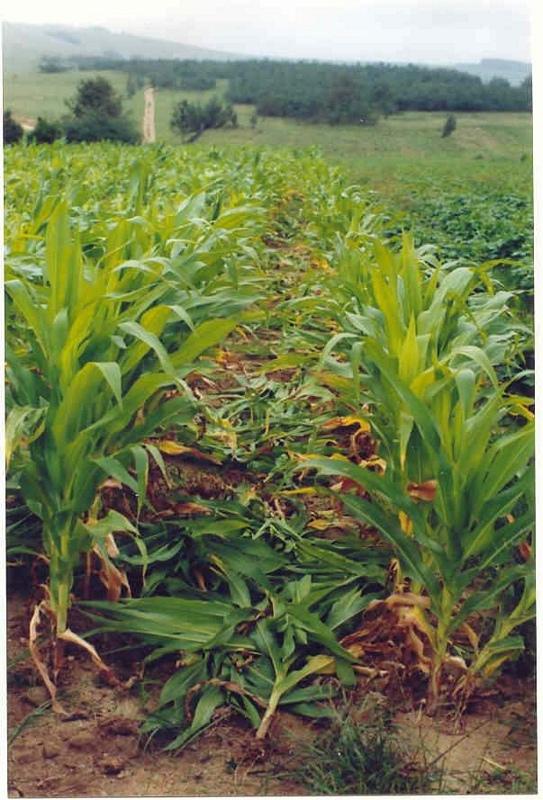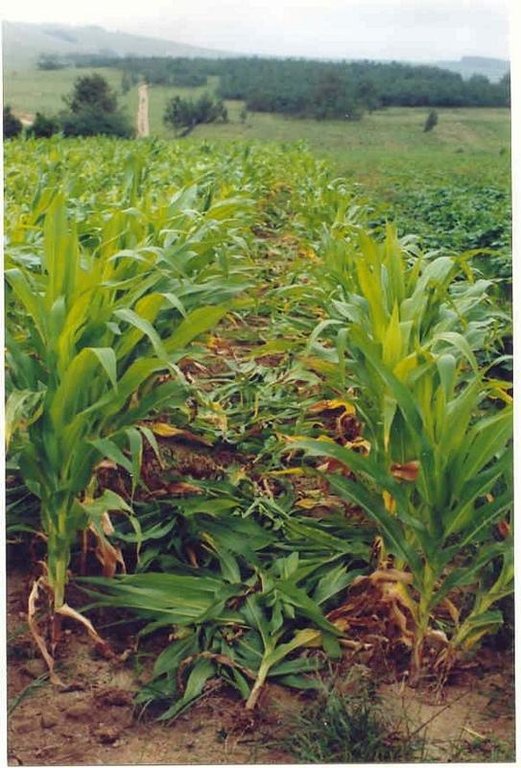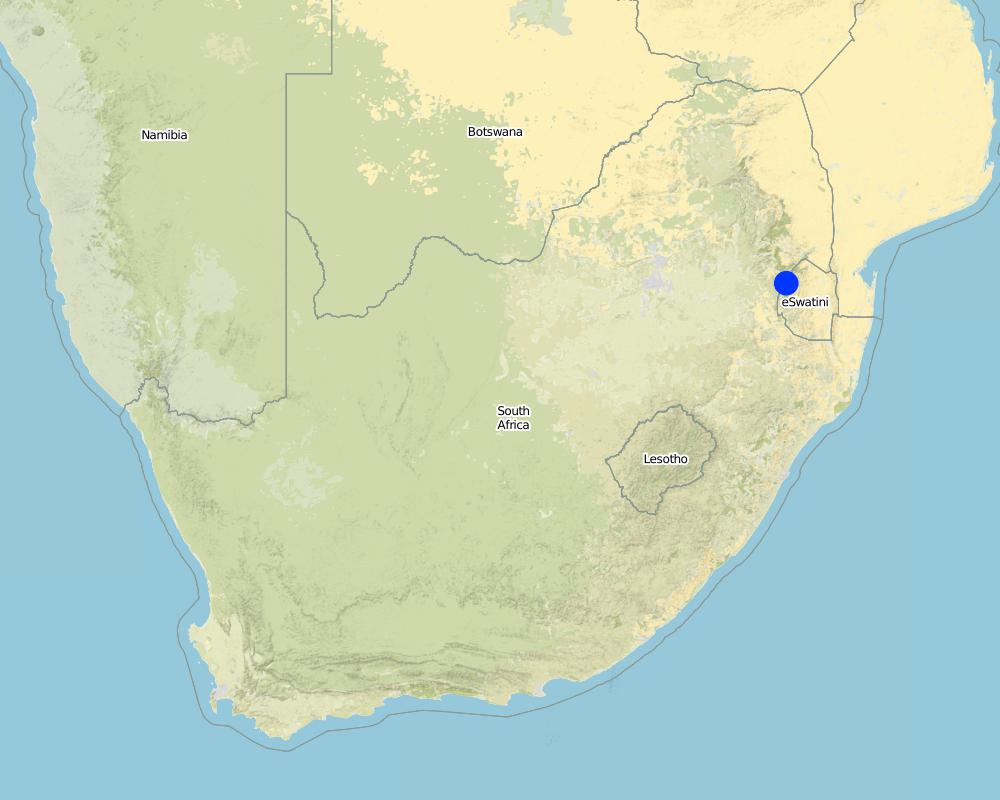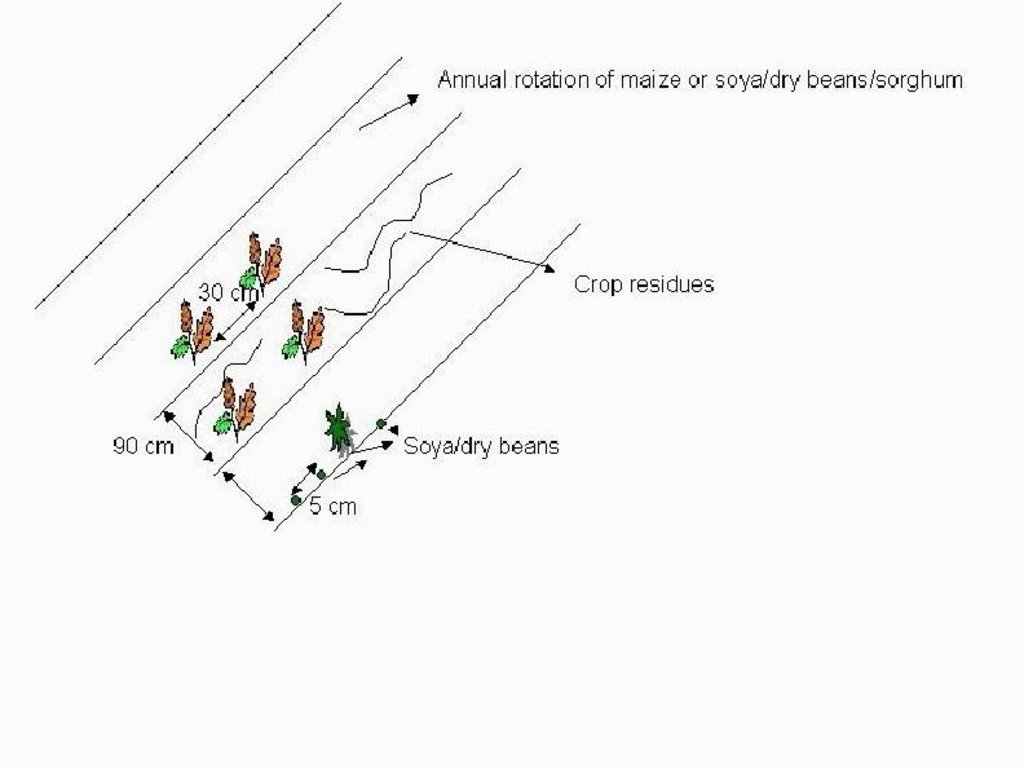Conservation Agriculture [South Africa]
- Creation:
- Update:
- Compiler: Hester Gertruida Jansen van Rensburg
- Editor: –
- Reviewers: David Streiff, Alexandra Gavilano
Planting without ploughing/no-till
technologies_976 - South Africa
View sections
Expand all Collapse all1. General information
1.2 Contact details of resource persons and institutions involved in the assessment and documentation of the Technology
Name of the institution(s) which facilitated the documentation/ evaluation of the Technology (if relevant)
Agricultural Research Council (ARC) - South Africa1.3 Conditions regarding the use of data documented through WOCAT
The compiler and key resource person(s) accept the conditions regarding the use of data documented through WOCAT:
Ja
1.5 Reference to Questionnaire(s) on SLM Approaches (documented using WOCAT)
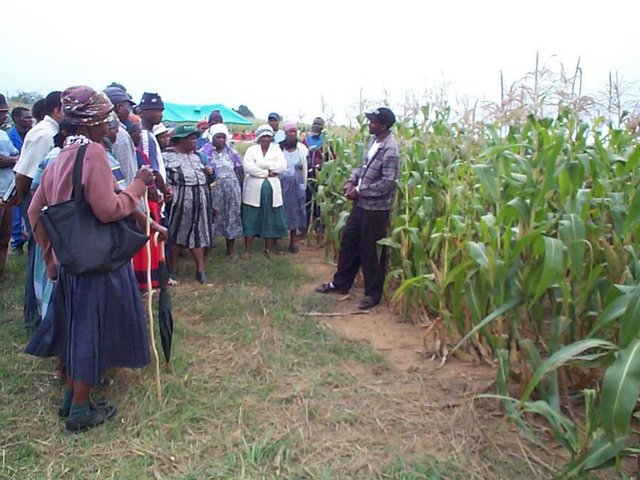
Farmers involved in own development [South Africa]
Planting without ploughing in a crop rotation system to improve moisture management, reduce erosion and increase crop yield.
- Compiler: Hester Gertruida Jansen van Rensburg

Multi-stakeholder LandCare process [South Africa]
A multi-stakeholder approach using action research methodologies to implement conservation agriculture
- Compiler: Hendrik Johannes Smith
2. Description of the SLM Technology
2.1 Short description of the Technology
Definition of the Technology:
Conservation agriculture included aspects such as crop rotation, mulching and no-tillage.
2.2 Detailed description of the Technology
Description:
The goal of conservation agriculture is to maintain and improve crop yields and at the same time protect and stimulate the biological binding functioning of the soil. The essential features of conservation agriculture are no-tillage, maintenance of cover (live or dead vegetal material) and crop rotation. Crops are planted through the cover with special equipment or (in the case of Mlondozi) by making holes in the ground with a hand hoe.
Soil cover inhibits erosion and the germination of weed seeds; it improves soil and water retention and reduces compaction.
Crop-seeds are planted without prior ploughing. If a plough sole exists, soil has to be ripped, if not, crop seeds can be planted. It is advisable to move gradually from tillage to no-tillage over a period of 4-5 years, starting with a crop that produces enough organic material (2-3 ton dry material annually).
2.3 Photos of the Technology
2.5 Country/ region/ locations where the Technology has been applied and which are covered by this assessment
Country:
South Africa
Region/ State/ Province:
Mpumalanga
Further specification of location:
Mlondozi
Specify the spread of the Technology:
- evenly spread over an area
If the Technology is evenly spread over an area, specify area covered (in km2):
5.2
If precise area is not known, indicate approximate area covered:
- 1-10 km2
Comments:
Total area covered by the SLM Technology is 5.2 km2.
Total technology area is approximately 300 ha.
Map
×2.6 Date of implementation
If precise year is not known, indicate approximate date:
- less than 10 years ago (recently)
2.7 Introduction of the Technology
Specify how the Technology was introduced:
- through projects/ external interventions
Comments (type of project, etc.):
Technology was implemented in several countries in the world e.g. Brasilia/Argentina/Australia/North America and African countries such as Zimbabwe, Zambia, e.g.
3. Classification of the SLM Technology
3.1 Main purpose(s) of the Technology
- improve production
- reduce, prevent, restore land degradation
- conserve ecosystem
3.2 Current land use type(s) where the Technology is applied

Cropland
- Annual cropping
Annual cropping - Specify crops:
- cereals - maize
Number of growing seasons per year:
- 1
Specify:
Longest growing period in days: 170; Longest growing period from month to month: Nov - Apr
Is crop rotation practiced?
Ja
Comments:
major cash crop and major food crop: Maize
Major land use problems (compiler’s opinion): - Soil compaction (plough layer) . - Reduced soil fertility. - Soil acidity. - Overgrazing. - Lack of implements. - Lack of land tenure.
Major land use problems (land users’ perception): - Lack of land tenure. - Lack of money.
3.4 Water supply
Water supply for the land on which the Technology is applied:
- rainfed
3.5 SLM group to which the Technology belongs
- improved ground/ vegetation cover
- minimal soil disturbance
- integrated soil fertility management
3.6 SLM measures comprising the Technology

agronomic measures
- A3: Soil surface treatment
A3: Differentiate tillage systems:
A 3.1: No tillage

vegetative measures

structural measures

management measures
Comments:
Main measures: agronomic measures, vegetative measures, management measures
Secondary measures: structural measures
Type of agronomic measures: better crop cover, mulching, mineral (inorganic) fertilizers, rotations / fallows, breaking compacted topsoil, zero tillage / no-till, breaking compacted subsoil
3.7 Main types of land degradation addressed by the Technology

soil erosion by water
- Wt: loss of topsoil/ surface erosion
- Wg: gully erosion/ gullying

chemical soil deterioration
- Cn: fertility decline and reduced organic matter content (not caused by erosion)

water degradation
- Ha: aridification
Comments:
Secondary types of degradation addressed: Wt: loss of topsoil / surface erosion, Wg: gully erosion / gullying
Main causes of degradation: other human induced causes (specify) (Agricultural causes), other natural causes (avalanches, volcanic eruptions, mud flows, highly susceptible natural resources, extreme topography, etc.) specify, education, access to knowledge and support services (Lack of knowledge)
Secondary causes of degradation: over-exploitation of vegetation for domestic use, overgrazing, land tenure (No land deeds), poverty / wealth (Lack of captial)
3.8 Prevention, reduction, or restoration of land degradation
Specify the goal of the Technology with regard to land degradation:
- prevent land degradation
- reduce land degradation
4. Technical specifications, implementation activities, inputs, and costs
4.1 Technical drawing of the Technology
Technical specifications (related to technical drawing):
Technical drawing
Location: Mlondozi. Mpumalanga
Technical knowledge required for field staff / advisors: moderate
Technical knowledge required for land users: low
Main technical functions: improvement of ground cover, increase in organic matter, increase of infiltration, increase / maintain water stored in soil, improvement of soil structure
Secondary technical functions: control of raindrop splash, control of dispersed runoff: retain / trap, control of dispersed runoff: impede / retard, control of concentrated runoff: retain / trap, control of concentrated runoff: impede / retard, control of concentrated runoff: drain / divert, increase of surface roughness, water harvesting / increase water supply, sediment retention / trapping, sediment harvesting, reduction in wind speed, increase in soil fertility
Better crop cover
Material/ species: maize/grass
Mulching
Material/ species: maize/legume
Agronomic measure: removing less vegetation cover
Material/ species: maize
Mineral (inorganic) fertilizers
Material/ species: 2:3:2 (22)
Soil conditioners (lime, gypsum)
Material/ species: lime
Rotations / fallows
Material/ species: soya/any beans
Major change in timing of activities: systems approach
Other type of management: change of management / intensity level
Author:
Hester Jansen van Rensburg
4.2 General information regarding the calculation of inputs and costs
other/ national currency (specify):
Rand
If relevant, indicate exchange rate from USD to local currency (e.g. 1 USD = 79.9 Brazilian Real): 1 USD =:
10.0
4.3 Establishment activities
| Activity | Timing (season) | |
|---|---|---|
| 1. | Exclude animals from field | Feb - April |
| 2. | Fencing | Once |
| 3. | Spraying of weeds | October |
4.4 Costs and inputs needed for establishment
Comments:
Duration of establishment phase: 48 month(s)
4.5 Maintenance/ recurrent activities
| Activity | Timing/ frequency | |
|---|---|---|
| 1. | No-tillage | Oct/Nov / Once with ploughing |
| 2. | Crop rotation | Oct/Nov / Every second year rotation |
| 3. | Keep lands weed free | Dec - Jan / Once - 3 times |
4.6 Costs and inputs needed for maintenance/ recurrent activities (per year)
| Specify input | Unit | Quantity | Costs per Unit | Total costs per input | % of costs borne by land users | |
|---|---|---|---|---|---|---|
| Fertilizers and biocides | Pesticide | ha | 1.0 | 20.0 | 20.0 | |
| Fertilizers and biocides | Save - ploughing | ha | 1.0 | 40.0 | 40.0 | |
| Total costs for maintenance of the Technology | 60.0 | |||||
| Total costs for maintenance of the Technology in USD | 6.0 | |||||
4.7 Most important factors affecting the costs
Describe the most determinate factors affecting the costs:
High weed population
5. Natural and human environment
5.1 Climate
Annual rainfall
- < 250 mm
- 251-500 mm
- 501-750 mm
- 751-1,000 mm
- 1,001-1,500 mm
- 1,501-2,000 mm
- 2,001-3,000 mm
- 3,001-4,000 mm
- > 4,000 mm
Specify average annual rainfall (if known), in mm:
800.00
Agro-climatic zone
- semi-arid
Short season, cold winters (moderate climate)
5.2 Topography
Slopes on average:
- flat (0-2%)
- gentle (3-5%)
- moderate (6-10%)
- rolling (11-15%)
- hilly (16-30%)
- steep (31-60%)
- very steep (>60%)
Landforms:
- plateau/plains
- ridges
- mountain slopes
- hill slopes
- footslopes
- valley floors
Altitudinal zone:
- 0-100 m a.s.l.
- 101-500 m a.s.l.
- 501-1,000 m a.s.l.
- 1,001-1,500 m a.s.l.
- 1,501-2,000 m a.s.l.
- 2,001-2,500 m a.s.l.
- 2,501-3,000 m a.s.l.
- 3,001-4,000 m a.s.l.
- > 4,000 m a.s.l.
5.3 Soils
Soil depth on average:
- very shallow (0-20 cm)
- shallow (21-50 cm)
- moderately deep (51-80 cm)
- deep (81-120 cm)
- very deep (> 120 cm)
Soil texture (topsoil):
- medium (loamy, silty)
- fine/ heavy (clay)
Topsoil organic matter:
- medium (1-3%)
- low (<1%)
If available, attach full soil description or specify the available information, e.g. soil type, soil PH/ acidity, Cation Exchange Capacity, nitrogen, salinity etc.
Soil fertility is low - medium
Soil drainage / infiltration is medium
Soil water storage capacity is medium
5.6 Characteristics of land users applying the Technology
Market orientation of production system:
- subsistence (self-supply)
Off-farm income:
- > 50% of all income
Relative level of wealth:
- poor
- very rich
Level of mechanization:
- manual work
- mechanized/ motorized
Indicate other relevant characteristics of the land users:
65% of the land users are very rich.
5% of the land users are average wealthy.
30% of the land users are poor.
Off-farm income specification: Pensions to by inputs.
Level of mechanization: Animal traction is possible, but less common
5.7 Average area of land used by land users applying the Technology
- < 0.5 ha
- 0.5-1 ha
- 1-2 ha
- 2-5 ha
- 5-15 ha
- 15-50 ha
- 50-100 ha
- 100-500 ha
- 500-1,000 ha
- 1,000-10,000 ha
- > 10,000 ha
Comments:
Average area of land owned or leased by land users applying the Technology: Also 5-15 ha
5.8 Land ownership, land use rights, and water use rights
Land ownership:
- individual, not titled
Land use rights:
- leased
6. Impacts and concluding statements
6.1 On-site impacts the Technology has shown
Socio-economic impacts
Production
crop production
Quantity before SLM:
0.5 t/ha
Quantity after SLM:
4.5 t/ha
fodder production
fodder quality
Income and costs
workload
Socio-cultural impacts
community institutions
Comments/ specify:
Groups formed - meetings
SLM/ land degradation knowledge
Comments/ specify:
Monitored
Ecological impacts
Water cycle/ runoff
excess water drainage
Soil
soil moisture
soil cover
Quantity before SLM:
10 %
Quantity after SLM:
50 %
Other ecological impacts
soil fertility
biodiversity
Comments/ specify:
Introduction of multi purpose crops/legumes.
6.2 Off-site impacts the Technology has shown
downstream flooding
6.4 Cost-benefit analysis
How do the benefits compare with the establishment costs (from land users’ perspective)?
Short-term returns:
very positive
Long-term returns:
very positive
How do the benefits compare with the maintenance/ recurrent costs (from land users' perspective)?
Short-term returns:
very positive
Long-term returns:
very positive
6.5 Adoption of the Technology
- > 50%
If available, quantify (no. of households and/ or area covered):
220 households
Of all those who have adopted the Technology, how many did so spontaneously, i.e. without receiving any material incentives/ payments?
- 11-50%
Comments:
200 land user families have adopted the Technology with external material support
Comments on acceptance with external material support: survey results
20 land user families have adopted the Technology without any external material support
Comments on spontaneous adoption: estimates
There is a moderate trend towards spontaneous adoption of the Technology
6.7 Strengths/ advantages/ opportunities of the Technology
| Strengths/ advantages/ opportunities in the land user’s view |
|---|
|
Increase yields How can they be sustained / enhanced? Training |
| Cheaper way of planting |
|
Improve water infiltration How can they be sustained / enhanced? Mulch |
|
Reduce erosion How can they be sustained / enhanced? Mulch |
| Time saving |
| Strengths/ advantages/ opportunities in the compiler’s or other key resource person’s view |
|---|
|
Early planting - not dependant on tractors and ploughs How can they be sustained / enhanced? Training |
|
Soil - reduce soil erosion How can they be sustained / enhanced? Increase in organic material in soil |
|
Weed control - reduce weed population How can they be sustained / enhanced? Use of herbicides |
|
Improve water retention - lower risk of draught periods How can they be sustained / enhanced? Mulch |
|
Reduction in input cost (R500/ha) Increase yields |
6.8 Weaknesses/ disadvantages/ risks of the Technology and ways of overcoming them
| Weaknesses/ disadvantages/ risks in the land user’s view | How can they be overcome? |
|---|---|
| Lack of no-till implements |
| Weaknesses/ disadvantages/ risks in the compiler’s or other key resource person’s view | How can they be overcome? |
|---|---|
| Lack of mechanisation of no-till implements | Exposure to implements |
7. References and links
7.1 Methods/ sources of information
7.2 References to available publications
Title, author, year, ISBN:
Demonstration & Assessment of sustainable land management practices in the Mlondozi district of Mpumalanga. Du Preez, Kidson, Beukes & Smith. 1998/1999/2000.
Available from where? Costs?
ARC - ISCW
Links and modules
Expand all Collapse allLinks

Farmers involved in own development [South Africa]
Planting without ploughing in a crop rotation system to improve moisture management, reduce erosion and increase crop yield.
- Compiler: Hester Gertruida Jansen van Rensburg

Multi-stakeholder LandCare process [South Africa]
A multi-stakeholder approach using action research methodologies to implement conservation agriculture
- Compiler: Hendrik Johannes Smith
Modules
No modules


